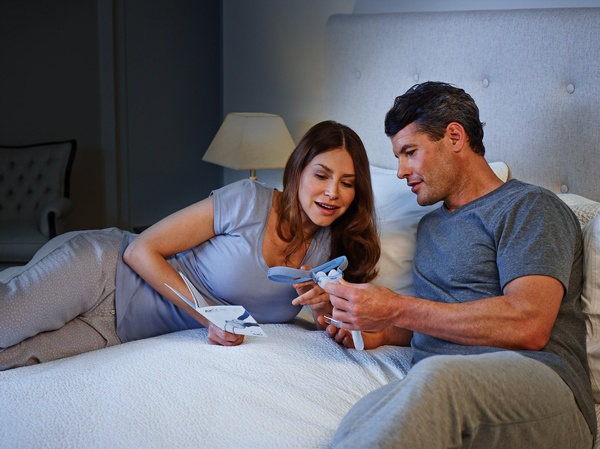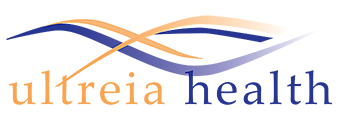Positive Airway Pressure (PAP) therapy is a form of treatment for sleep apnea that uses air under pressure to splint open the airway while a person sleeps. A small machine draws in air from the room and gently blows it at a prescribed pressure level through tubing connected to a mask that the individual wears while they sleep. Masks can either fit at the nose, over the nose, or over the nose and mouth depending on what is most comfortable for that individual. The air under pressure acts to keep the airway open, preventing narrowing that causes snoring, and obstruction that disrupts sleep, and allowing the person to breathe more effectively while they sleep.
Types of PAP Therapy
Continuous Positive Airway Pressure (CPAP)
 CPAP, or Continuous Positive Airway Pressure, is considered the treatment of choice for moderate to severe obstructive sleep apnea. Patients with mild sleep apnea and symptoms of the disorder can also benefit from CPAP therapy. A CPAP device consists of a blower-motor that pressurizes filtered air, directs this air through a humidifier, and delivers the humidified air through tubing to a nasal mask. Nasal masks can fit in the nose (nasal pillows), or over the nose (nasal mask), or over the nose and mouth (full face mask). The air is directed through the mask to the throat area where it splints open the walls of the throat, enabling the airway to stay open for effective breathing during sleep. An optimal pressure, considered to be the lowest tolerated pressure that reduces the frequency of airway obstructions to <5/hr., is determined by either a repeat laboratory sleep study with a patient using CPAP, or by other means, including the use of download data from an auto-adjusting CPAP machine. Determining an “optimal” pressure can be difficult because the pressure needed to stabilize the airway varies depending on a number of factors including sleep position (supine sleep requires higher pressures), stage of sleep (REM sleep typically requires higher pressure), and the use of alcohol, or pain medication (increase the tendency for sleep apnea requiring higher pressure settings). The CPAP equipment is quiet when it is operating properly, so that it will not typically disturb you, or your bed-partner. Device size has progressively become smaller, and devices are very portable, enabling you to take the equipment with you more easily when traveling.
Most patients will have a period of time during which they acclimate, or adjust to the CPAP therapy. The length of time that it takes get comfortable using CPAP varies among individuals, and is difficult to predict. Typically, most patients will struggle initially with the therapy, but adjust to wearing CPAP within a few days to a few weeks. For some, the time period to adjust to wearing CPAP may be longer. Persistence with the therapy is important when acclimating to CPAP, as most individuals notice that the therapy is less bothersome, and easier to tolerate the more they use it. Though most CPAP users notice benefit in how they feel when they are able to use the device for most of the night, for some, maximum symptom relief may take weeks or months.
CPAP, or Continuous Positive Airway Pressure, is considered the treatment of choice for moderate to severe obstructive sleep apnea. Patients with mild sleep apnea and symptoms of the disorder can also benefit from CPAP therapy. A CPAP device consists of a blower-motor that pressurizes filtered air, directs this air through a humidifier, and delivers the humidified air through tubing to a nasal mask. Nasal masks can fit in the nose (nasal pillows), or over the nose (nasal mask), or over the nose and mouth (full face mask). The air is directed through the mask to the throat area where it splints open the walls of the throat, enabling the airway to stay open for effective breathing during sleep. An optimal pressure, considered to be the lowest tolerated pressure that reduces the frequency of airway obstructions to <5/hr., is determined by either a repeat laboratory sleep study with a patient using CPAP, or by other means, including the use of download data from an auto-adjusting CPAP machine. Determining an “optimal” pressure can be difficult because the pressure needed to stabilize the airway varies depending on a number of factors including sleep position (supine sleep requires higher pressures), stage of sleep (REM sleep typically requires higher pressure), and the use of alcohol, or pain medication (increase the tendency for sleep apnea requiring higher pressure settings). The CPAP equipment is quiet when it is operating properly, so that it will not typically disturb you, or your bed-partner. Device size has progressively become smaller, and devices are very portable, enabling you to take the equipment with you more easily when traveling.
Most patients will have a period of time during which they acclimate, or adjust to the CPAP therapy. The length of time that it takes get comfortable using CPAP varies among individuals, and is difficult to predict. Typically, most patients will struggle initially with the therapy, but adjust to wearing CPAP within a few days to a few weeks. For some, the time period to adjust to wearing CPAP may be longer. Persistence with the therapy is important when acclimating to CPAP, as most individuals notice that the therapy is less bothersome, and easier to tolerate the more they use it. Though most CPAP users notice benefit in how they feel when they are able to use the device for most of the night, for some, maximum symptom relief may take weeks or months.
The use of auto-titrating CPAP devices, or “auto CPAP,” has become more popular. These devices use an algorithm to determine the presence of airway narrowing with snoring, or obstruction, and then adjust the pressure either higher (with narrowing, or airflow limitation present), or lower (if a period of time has passed with no narrowing, or airflow limitation). The algorithm used in a particular device varies among manufacturers. Auto CPAP machines typically result in lower pressures over the course of a night (as compared with a standard CPAP set at one “optimal” pressure), and may improve compliance, or use of the devices, and comfort with the devices. Some insurance companies require the use of auto-adjusting PAP devices in an effort to reduce laboratory studies to determine treatment pressures.
Bilevel Positive Airway Pressure (BIPAP)
BIPAP, or bilevel positive airway pressure therapy, treats sleep apnea similarly to CPAP, with flow of pressurized air delivered through the nose, or nose and mouth. BIPAP differs from CPAP in that the air pressure delivered varies during a breath. During inspiration (taking a breath in), a higher pressure is delivered to help splint the airway open. During exhalation (breathing out) a lower pressure is delivered to make it easier to exhale against the airflow. BIPAP is often useful when higher pressures are needed to splint the airway open, and in some patients who have difficulty exhaling against pressure. In addition, BIPAP can be used in individuals who have difficult to manage mouth leak of air, or who develop gaseous distention of the gastrointestinal tract with symptoms of belching, abdominal cramps, or increased passed gas. BIPAP represents a more complex therapy, and devices are more expensive than CPAP. Most insurers require a trial, and failure of CPAP therapy, before covering BIPAP therapy.
As with CPAP, most patients will experience a period of adjustment during which they may struggle some with the therapy as they learn how to breathe with the device. With persistence, most patients are able to acclimate to the therapy, and experience improvement in sleep quality and symptoms. Auto adjusting BIPAP devices are also available.
Adaptive Pressure Ventilation (ASV)
An adaptive pressure ventilation device (ASV) delivers a specialized treatment for individuals who have a more complicated form of breathing that does not respond as well to CPAP or to BIPAP. Individuals may be prescribed an ASV device if they are found to have an increased frequency of central apneas (periods of apneas where no patient effort to breathe occurs). This can be seen in patients with heart failure, or persons taking opioid pain medication, or a subset of patients who develop central apneas when placed on PAP therapy (complex sleep apnea). Information from an in-lab PAP titration study, or information downloaded from a CPAP, or BIPAP device can help determine whether there is an increased frequency of abnormal respiratory events that remain in spite of treatment, and whether the residual events are central apneas.

